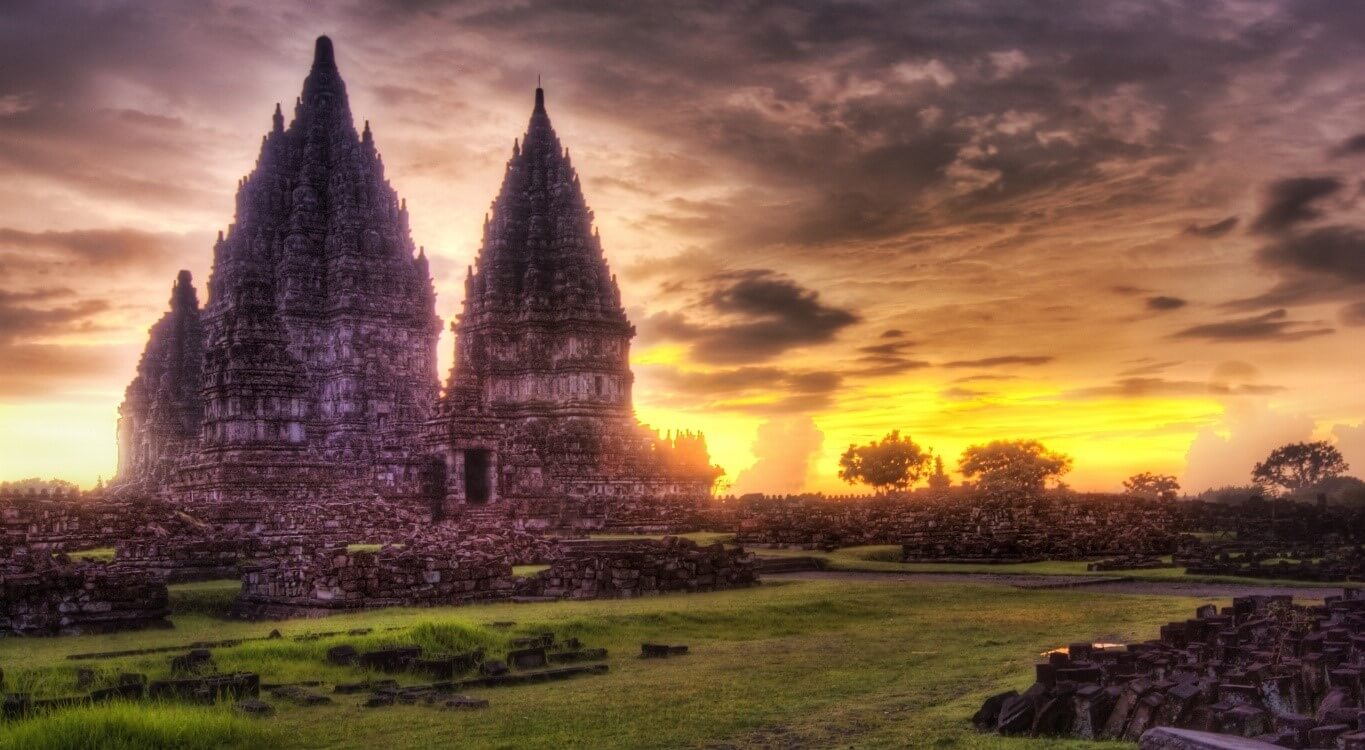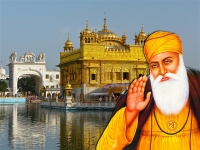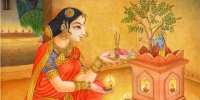
The common religion of India, based upon the religion of the original Aryan settlers as expounded and evolved in the Vedas, the Upanishads, the Bhagavad-Gita, etc., having an extremely diversified character with many schools of philosophy and theology, many popular cults, and a large pantheon symbolizing the many attributes of a single god. Buddhism and Jainism are outside the Hindu tradition but are regarded as related religions.
Introduction to Hinduism
Hinduism is the religion of the majority of people in India and Nepal. It also exists among significant populations outside of the sub continent and has over 900 million adherents worldwide.
In some ways Hinduism is the oldest living religion in the world, or at least elements within it stretch back many thousands of years. Yet Hinduism resists easy definition partly because of the vast array of practices and beliefs found within it. It is also closely associated conceptually and historically with the other Indian religions Jainism, Buddhism and Sikhism.
Unlike most other religions, Hinduism has no single founder, no single scripture, and no commonly agreed set of teachings. Throughout its extensive history, there have been many key figures teaching different philosophies and writing numerous holy books. For these reasons, writers often refer to Hinduism as 'a way of life' or 'a family of religions' rather than a single religion.
Defining Hinduism
The term 'Hindu' was derived from the river or river complex of the northwest, the Sindhu. Sindhu is a Sanskrit word used by the inhabitants of the region, the Aryans in the second millennium BCE. Later migrants and invaders,
the Persians in the sixth century BCE, the Greeks from the 4th century BCE, and the Muslims from the 8th century CE, used the name of this river in their own languages for the land and its people.
The term 'Hindu' itself probably does not go back before the 15th and 16th centuries when it was used by people to differentiate themselves from followers of other traditions, especially the Muslims (Yavannas), in Kashmir and Bengal. At that time the term may have simply indicated groups united by certain cultural practices such as cremation of the dead and styles of cuisine. The 'ism' was added to 'Hindu' only in the 19th century in the context of British colonialism and missionary activity.
The origins of the term 'hindu' are thus cultural, political and geographical. Now the term is widely accepted although any definition is subject to much debate. In some ways it is true to say that Hinduism is a religion
of recent origin yet its roots and formation go back thousands of years.
Some Hindus define orthodoxy as compliance with the teachings of the Vedic texts (the four Vedas and their supplements). However, still others identify their tradition with 'Sanatana Dharma', the eternal order of conduct that transcends any specific body of sacred literature. Scholars sometimes draw attention to the caste system as a defining feature, but many Hindus view such practices as merely a social phenomenon or an aberration of their original teachings. Nor can we define Hinduism according to belief in concepts such as karma and samsara (reincarnation) because Jains, Sikhs, and Buddhists (in a qualified form) accept this teaching too.
Purusharthas (objectives of human life)
Dharma (righteousness, ethics)
Dharma is considered the foremost goal of a human being in Hinduism. The concept Dharma includes behaviors that are considered to be in accord with rta, the order that makes life and universe possible, and includes duties, rights, laws, conduct, virtues and "right way of living". Hindu Dharma includes the religious duties, moral rights and duties of each individual, as well as behaviors that enable social order, right conduct, and those that are virtuous. Dharma, according to Van Buitenen, is that which all existing beings must accept and respect to sustain harmony and order in the world. It is, states Van Buitenen, the pursuit and execution of one's nature and true calling, thus playing one's role in cosmic concert. The Brihadaranyaka
Upanishad states it as:
Nothing is higher than Dharma. The weak overcomes the stronger by Dharma, as over a king. Truly that Dharma is the Truth (Satya); Therefore, when a man speaks the Truth, they say, "He speaks the Dharma"; and if he speaks Dharma,they say, "He speaks the Truth!" For both are one.
Artha (livelihood, wealth)
Artha is objective and virtuous pursuit of wealth for livelihood, obligations and economic prosperity. It is inclusive of political life, diplomacy and material well-being. The Artha concept includes all "means of life", activities and resources that enables one to be in a state one wants to be in, wealth, career and financial security. The proper pursuit of artha is considered an important aim of human life in Hinduism.
Kāma (sensual pleasure)
Kāma means desire, wish, passion, longing, pleasure of the senses, the aesthetic enjoyment of life, affection, or love, with or without sexual connotations. In Hinduism, Kama isconsidered an essential and healthy goal of human life when pursued without sacrificing Dharma, Artha and Moksha.
Mokṣa (liberation, freedom from samsara)

Moksha (Sanskrit: मोक्ष mokṣa) or mukti (Sanskrit: मुक्ति) is the ultimate, most important goal in Hinduism. In one sense, Moksha is a concept associated with liberation from sorrow, suffering and saṃsāra (birth-rebirth cycle). A release from this eschatological cycle, in after life, particularly in theistic schools of Hinduism is called moksha. In other schools of Hinduism, such as monistic, moksha is a goal achievable in current life, as a state of bliss through self-realization, of comprehending the nature of one's soul, of freedom and of "realizing the whole universe as the Self".
Main traditions
Hinduism has no central doctrinal authority and many practising Hindus do not claim to belong to any particular denomination or tradition. Four major denominations are, however, used in scholarly studies: Vaishnavism,
Shaivism, Shaktism and Smartism.These denominations differ primarily in the central deity worshipped, the traditions and the soteriological outlook. The denominations of Hinduism, states Lipner, are unlike those found in major religions of the world, because Hindu denominations are fuzzy with individuals practicing more than one, and he suggests the term "Hindu polycentrism".
Vaishnavism is the devotional religious tradition that worships Vishnu and his avatars, particularly Krishna and Rama. The adherents of this sect are generally non-ascetic, monastic, oriented towards community events and devotionalism practices inspired by "intimate loving, joyous, playful" Krishna and other Vishnu avatars. These practices sometimes include community dancing, singing of Kirtans and Bhajans, with sound and music believed by some to have meditative and spiritual powers. Temple worship and festivals are typically elaborate in Vaishnavism. The Bhagavad Gita and the Ramayana, along with Vishnu-oriented Puranas provide its theistic foundations. Philosophically, their beliefs are rooted in the dualism sub-schools of Vedantic Hinduism.
Principal Scriptures
1. The Vedas
There are four Vedas.The Rigveda is the first and the most important Veda. Each Veda is divided into four parts: the primary one, the Veda proper, being the Saṃhitā, which contains sacred mantras in verse. The other three parts form a three-tier ensemble of commentaries, usually in prose, which are historically believed to be slightly later in age than the Saṃhitā. These are: the Brāhmaṇas, Āraṇyakas, and the Upanishads. The first two parts are called the Karmakāṇḍa (the ritualistic portion), while the last two form the Jñānakāṇḍa.
The four Vedas constitute the most important body of sacred Hindu literature, at least in theory. Other sacred literature, especially the Hindu epics, may be more popular with readers, but the Vedas, written in the ancient
Sanskrit language, are the oldest and most respected scriptures. They are separately titled the Rigveda, Yajurveda, Sāmaveda, and atharvaveda, and collectively referred to as the Veda.
2. Upanishads
The Upanishads or the Vedanta, which mark the culmination of the abstract speculation and contain the riches philosophical and religious teachings, are mostly parts of the Aranyakas or the Forest Treatises. Many Aranyakas
are now lost, and only the Upanishadic portions of these profoundly philosophical books have escaped the erosion and ravages of time. There are many Upanishads, but the principal ones are sixteen or so in number. This whole
literature contains deep spiritual truths and philosophy. The central teaching of the Upanishads underline the identity of the Supreme Soul and the individual Soul.
3. Purānas
Purāna means "old". The Purānas are the later sacred literature of the Hindus. The Puranas are stories which expound the Vedic conclusions. There are many Purānas, but there are 18 major Purānas, and they can be classified according to which of the three Gods of the Hindu trinity they focus on—Brahmā, Vishnu, or Shiva. . Six Purānasdeal with Lord Vishnu, six address Lord Siva and six deal with Lord Brahma. They are usually in question and answer form. There are also Upa (additional) Purānas. The Purānas establish the meaning of the Vedas, as they are the natural commentaries on the Vedas. The most famous of these is the Bhāgavata Purāna, which deals with the life of Krishna, an avatar of Vishnu.
4. Ramayana

The Rāmāyaṇa consists of 24,000 verses in seven cantos (kāṇḍas) and tells the describes the life of Prince Rāma, an incarnation of Vishnu. Rāma and his wife Sītā embody virtue and righteousness, and their lives demonstrate Dharma in various spheres of activity. Their life stories contain lessons for Hindus on ideal behavior in various roles, such as son, brother, wife, king, and married couple. Rāma’s reign ushers in a golden age, and the expression Rāma-rajya (rule of Rāma) describes the best of times in which the divine presence rules on Earth.
5. Mahābhārata
The Mahābhārata, is consists of more than 74,000 verses, long prose passages, and some 1.8 million words in total, is the longest epic poem in the world. It is the foremost source concerning classical Indian civilization and
Hindu ideals. It traces the descendants of two sets of cousins, the Kauravas and the Pāndavas, whose disputes eventually lead to the Mahābhārata war. Krishna, an avatar of Vishnu, is central to the story. Like the Rāmāyana,
the Mahābhārata addresses many questions related to Dharma and the actions of individuals and society. These discourses have provided inspiration for Hindus in many areas of life.
6. Bhagavad-Gītā
The Bhagavad Gītā is comprised of 700 verses from the Mahabharata, functions virtually as a text on its own in Hinduism. The Bhagavad Gītā is revered as sacred by the majority of Hindu traditions. In general speech it is
commonly referred to as The Gita. The content of the text is a conversation between Krishna and Arjuna taking place on the battlefield of Kurukshetra just prior to the start of a climactic war. Responding to Arjuna's confusion
and moral dilemma, Krishna explains to Arjuna his duties as a famous warrior and Prince and elaborates on a number of different Yogas and Vedanta, with examples and analogies. This has led to the Gita often being
described as a concise guide to Hindu philosophy and also as a practical, self-contained guide to life. During the discourse, Krishna reveals his identity as the bhagavan (Supreme Being), blessing Arjuna with an awe-inspiring
glimpse of His divine absolute form.






